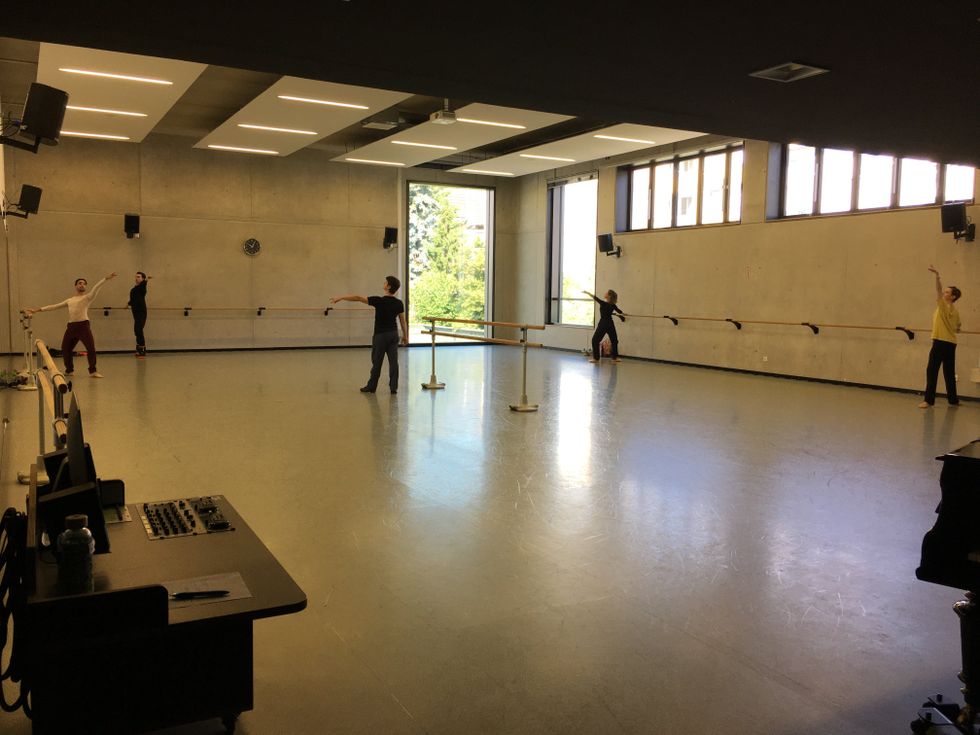Some Dance Companies Are Performing Again. But What Are the Risks of Reopening?
Though the idea of performing seems like a distant future in the United States, the first theaters are starting to reopen in Europe and Asia. The Hessian State Theater of Wiesbaden in Germany has even managed to put on new performances this month. But it’s far from business as usual. Dancers perform staying six meters apart and they wear protective gloves if they touch the floor. Masks are compulsory for backstage crew members, who have to remain more than one meter from each other.
The theater also spreads out the audience. Three empty seats are deliberately left between people, and only every other row is occupied. The theater’s large auditorium now holds only 200 audience members and the small one has space for 60.
Germany achieved reopening sooner than other countries, possibly due to its strong public health care system. When the virus struck, the government acted quickly with widespread testing, close tracking of new cases, and strict social distancing measures.
“Germany has a lot of rules,” says Ballet am Rhein co-director Remus Şucheană. It’s one reason why dance companies there have been able to start coming back sooner than in other countries.
Could they be an example for other dance organizations? And how can theaters protect dancers and staff members against the risk of coronavirus infection?
The situation varies from company to company. Before the 45 dancers of Ballet am Rhein could return to work, they had to sign a form agreeing to the new conditions. Dancers there are divided into three groups and train for 90 minutes on alternating days. In the studio, lines on the floor mark the safe distance between them. Afterward dancers have 20 minutes to change in one of eight individual dressing rooms.
Unfortunately, dance is a “high-risk activity,” says Dr. Benjamin Levine, professor of internal medicine at UT Southwestern Medical Center and Texas Health Presbyterian Dallas. It’s “intense exercise that requires intimate contact between people” in a closed space with people breathing heavily.
Before dancers start practicing, companies should require them to get tested for COVID-19. Levine contributed to a recent paper in the Journal of the American Medical Association, “A Game Plan for the Resumption of Sport and Exercise After Coronavirus Disease 2019 (COVID-19) Infection” which has guidelines for physical activity after a positive or negative result.
Dancers should also ask themselves every day whether they have any COVID-19-related symptoms and check their temperature. If they’re symptomatic or have a fever, they should stay home and possibly see a physician. Dance/USA’s Task Force on Dancer Health has put out a guide for safely returning to the studio.
Social distancing remains the best way to avoid coronavirus infection. “Six feet or two meters is what is recommended for people sitting quietly,” says Levine. But he says it’s better to “double your distance.”
Studios should contain hand sanitizer, and the floor, barre and mats must be rigorously cleaned to remove any coronavirus germs. Dancers must constantly wash their hands.

Monika Doll, courtesy Deutche Oper am Rhein
Dancers should also avoid large gatherings outside the studio and exposure to anyone who is COVID-19-positive. “They have to be prepared to do that for the entire duration of rehearsal and performances, especially while the outcome of this pandemic remains uncertain,” says Levine.
Staff members should wear masks and disinfect their hands frequently. (At some theaters, the costume departments have even made cloth masks for everyone.)
Of course, these recommendations depend on your environment. “The risk depends on the spread of the virus in the community where the dancers are,” says Levine. Companies should pay attention to any rise in the number of new cases in their area.
But planning for future performances remains a challenge. “We want to keep our art going as much as we can and show that we can at least do class,” says Aaron S. Watkin, artistic director of Dresden’s Semperoper Ballet. “To go any further under these rules is extremely difficult,” he adds.
In Germany, theaters receive very generous support from their state governments. Employees’ salaries can still be paid. But the situation may look very different for companies with smaller budgets and little to no government support.
Either way, flexibility and creativity remain key. For instance, before the pandemic, Ballet am Rhein was preparing a gala performance for Martin Schläpfer, the departing artistic director and chief choreographer. But the older works can’t be performed because the dancers come too close to each other. Şucheană has been rehearsing three new pieces that adhere to the coronavirus regulations.
The first day back was “amazing” says Şucheană. But now he’s hoping the government will be able to ease restrictions further. “So I don’t just have six or seven people in class, but maybe 15—so we feel like a company again.”




